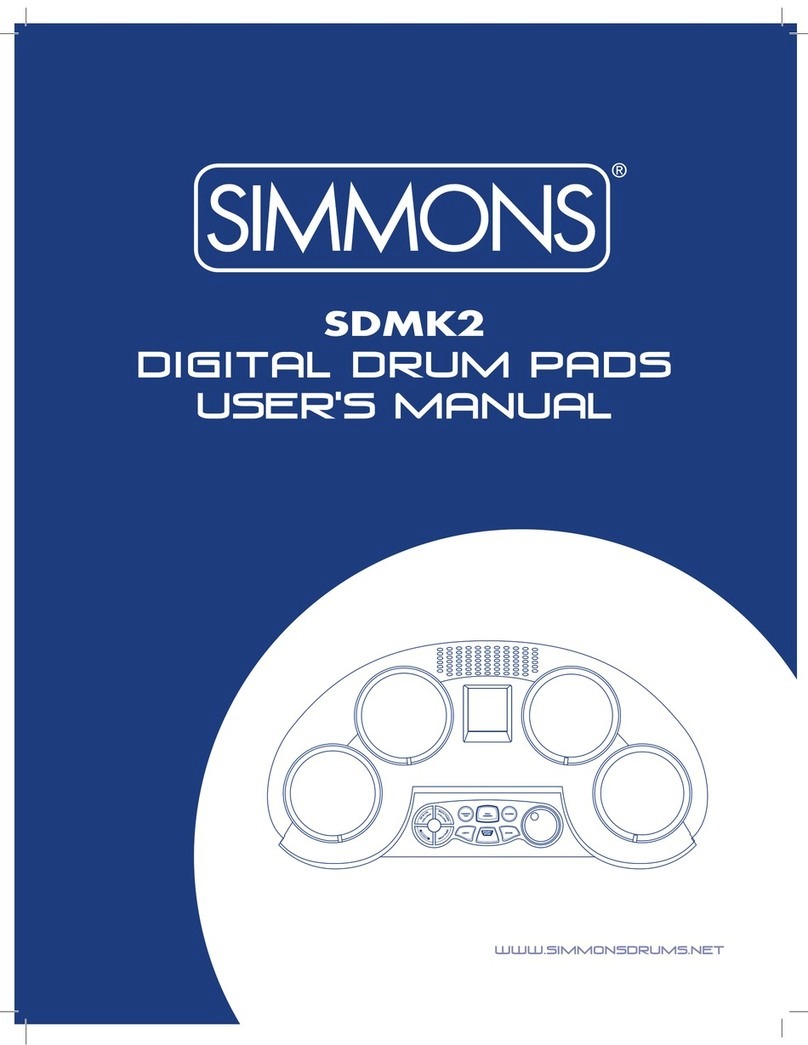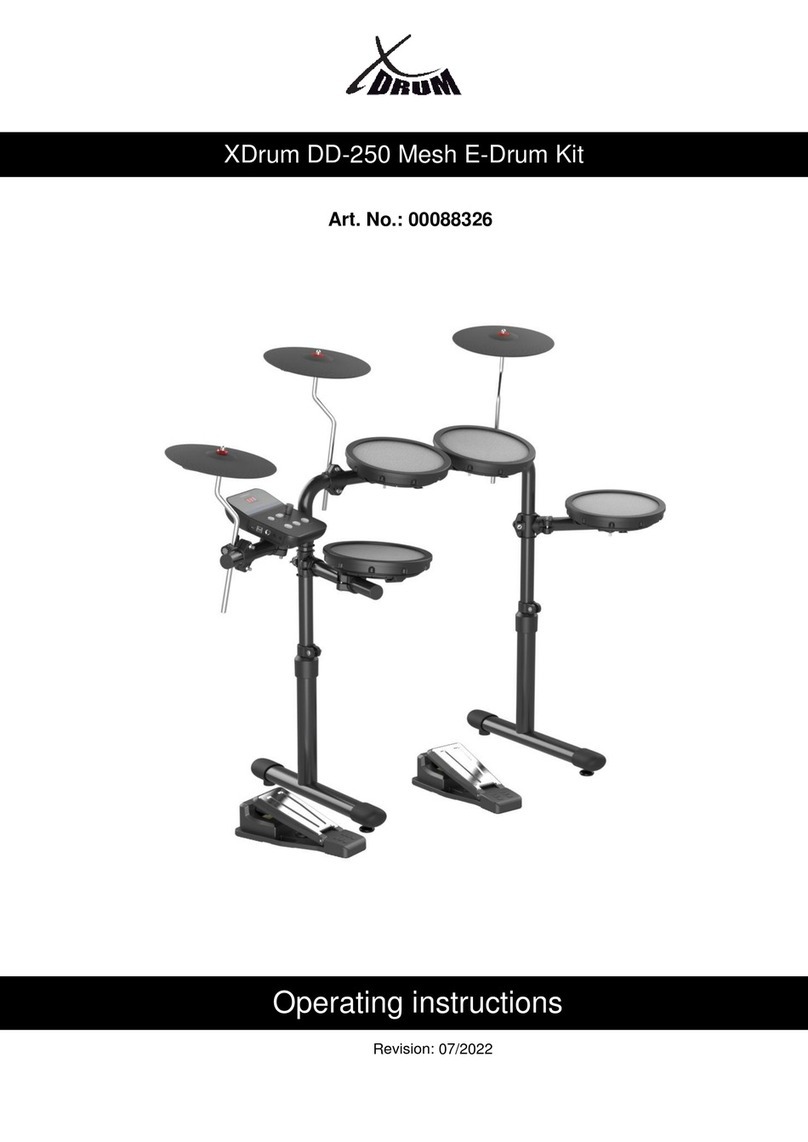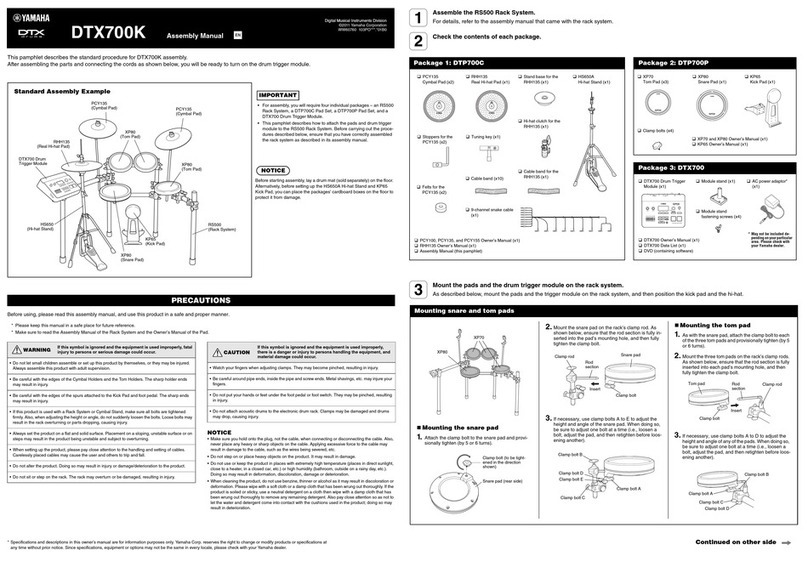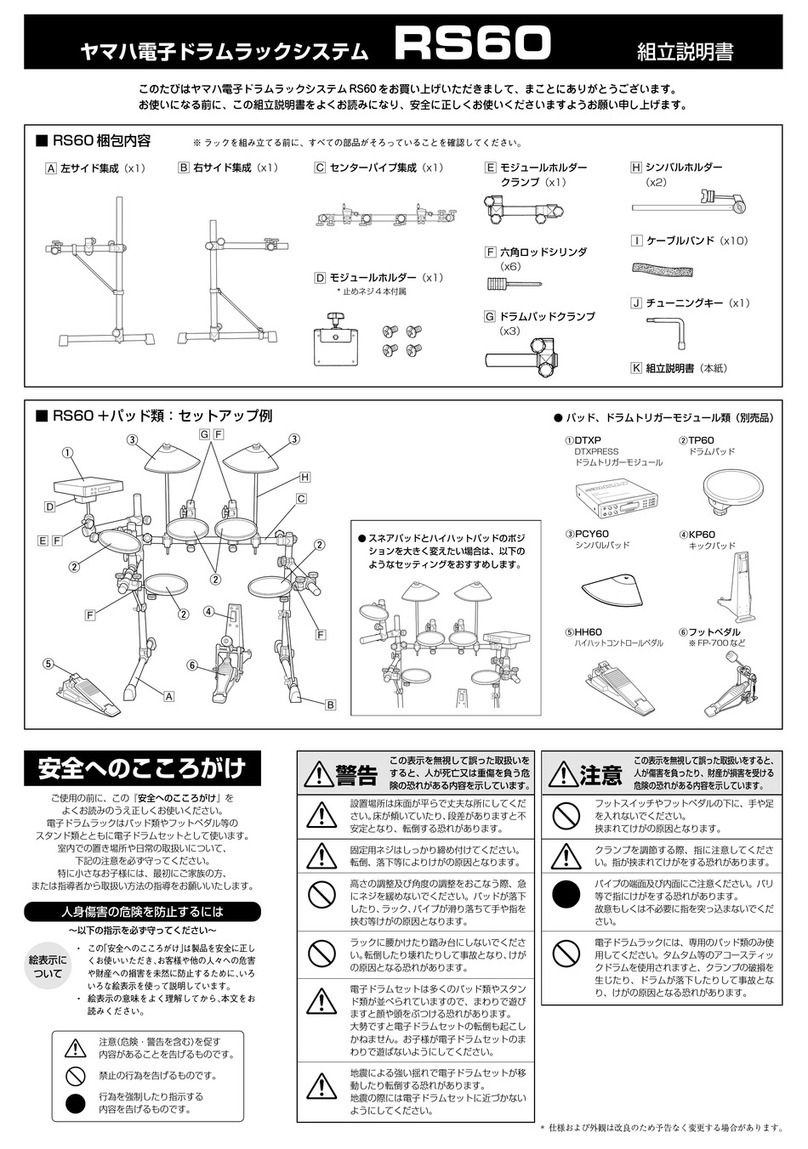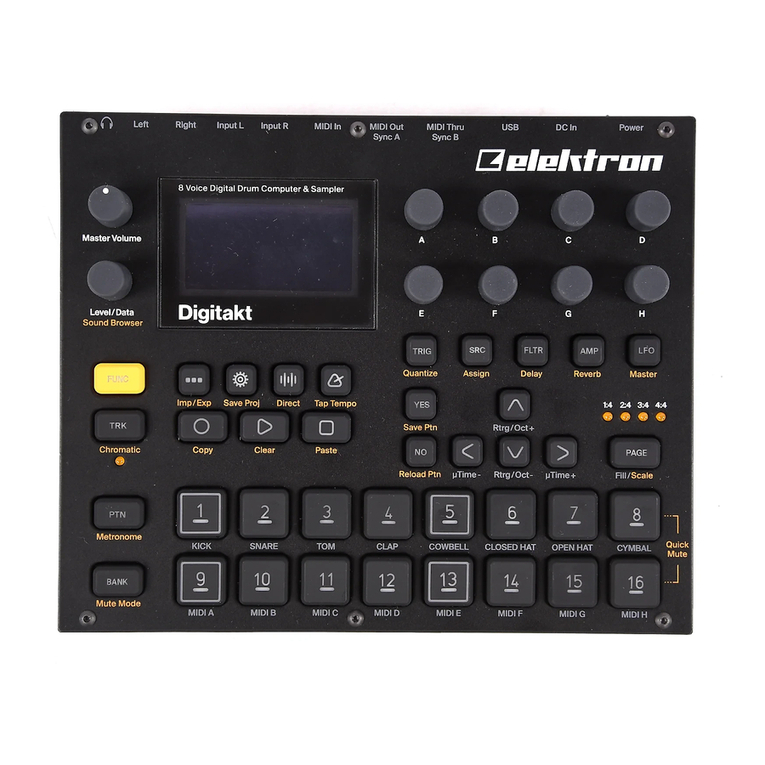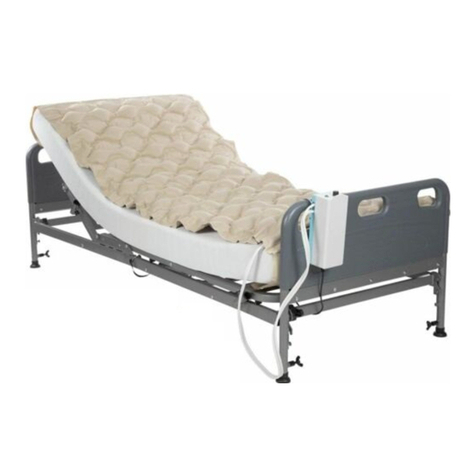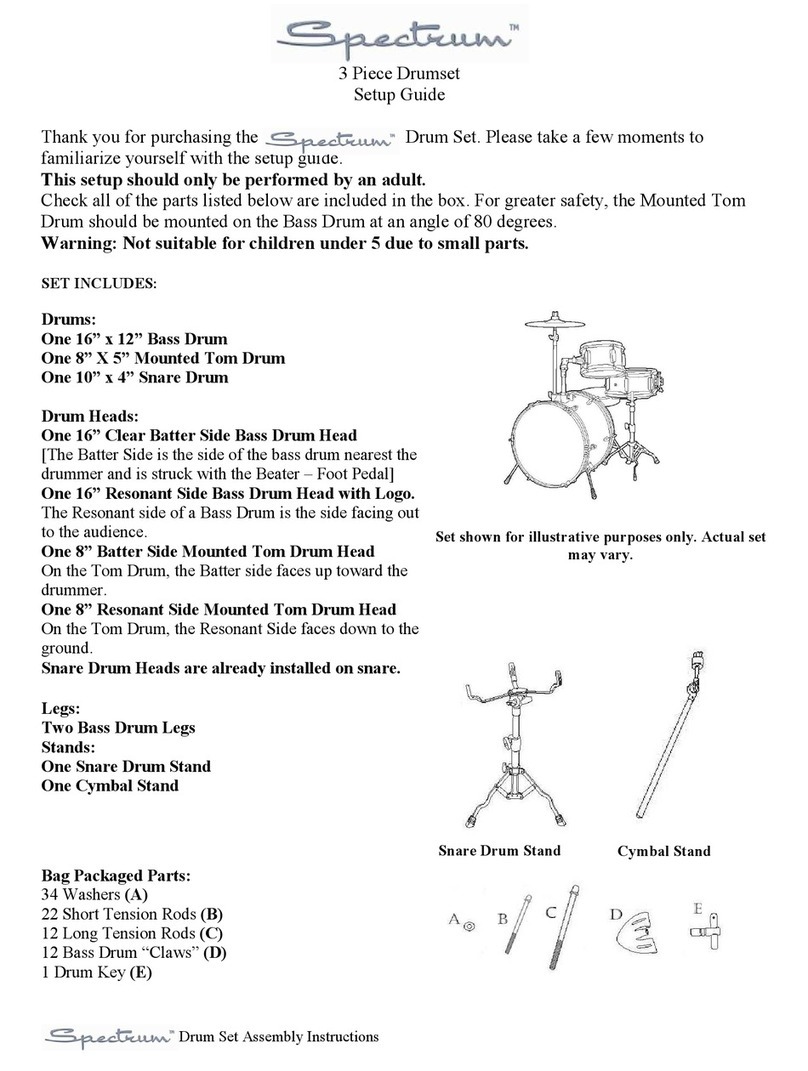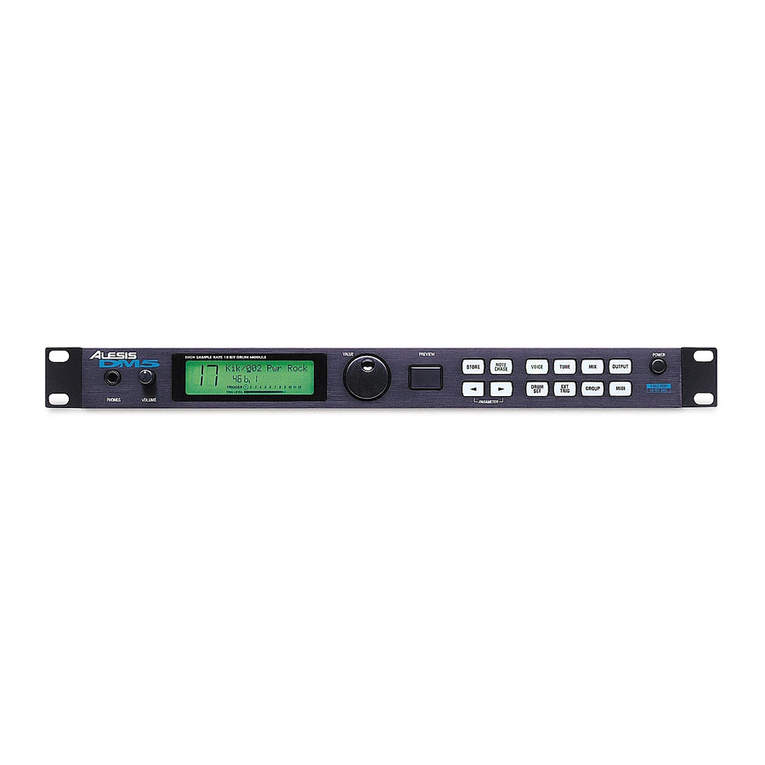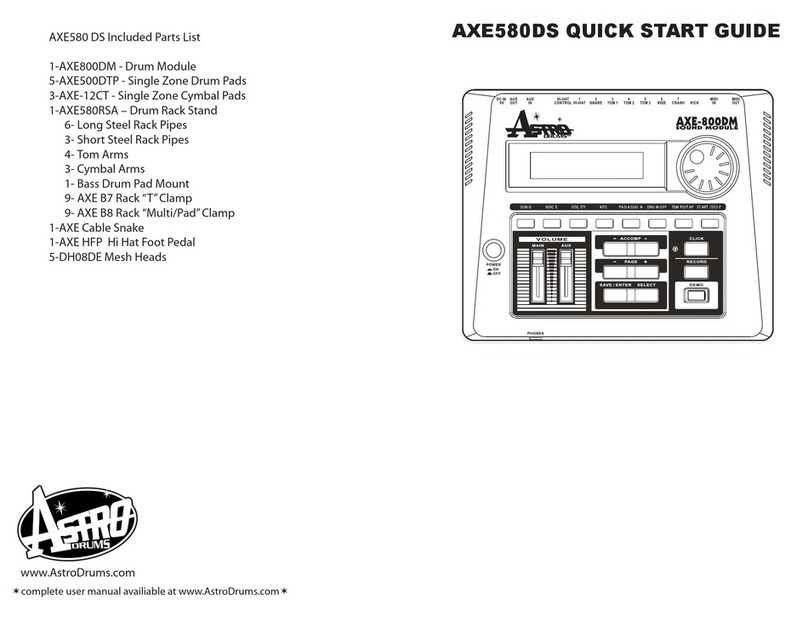Simmons SDS 8 User manual

SIMMONS
SDS 8
OPERATING INSTRUCTIONS

CONCEPT
The Simmons electronic drum kit, SDS 8, is part of a revolution that is currently
changing the face of drums. The “skins and shells” concept has remained basically
unchanged for thousands of years while every other instrument in rock music has
enjoyed the application of new technology, allowing them to evolve into more
creative and exciting tools for the making of music. At Simmons Electronics we
decided to do something about this injustice and dedicated ourselves to producing
percussion instruments for the eighties. By purchasing the SDS 8, you have joined
the front line of the revolution. CONGRATULATIONS! The SDS 8 is not a
complicated instrument, however we do request that you read this manual carefully as
it has been written to ensure that you are able to use your Simmons electronic drum
kit as creatively as possible.
GOOD LUCK.

ABOUT YOUR SDS 8
The SDS 8, (Simmons Drum Synthesizer 8), is an electronic drum kit which has been
designed to accurately reproduce the sound of a well amplified acoustic drum kit
while offering the infinite range of sounds available from modern electronics as
applied to musical instruments. The SDS 8 has individual channels for bass drum,
snare drum and three tom-toms. Each channel has a factory pre-set sound and a
programmable option enabling drummers to construct their own sounds. The controls
affect parameters that it would be desirable to adjust on acoustic drums and later in
this manual the explanation of these controls is made by relating their effect to the
individual components of an acoustic drum sound. This will give you the ability to
analyse an acoustic drum sound and program it electronically.
Each channel has two pre-sets –the first is a factory programmed sound and the
second can be programmed by you to create your own unique drum sound. The
factory and user programmed sounds can be selected on each channel individually and
a footswitch facilitates the simultaneous switching of all five channels from one pre-
set sound to the other.
A stereo mixer is built into the synthesizer console, along with individual audio
outputs for each channel. The subject of amplifying the SDS 8 is covered in some
depth later in this manual.
The drum pads are fitted with newly developed “softened” playing surfaces which
closely emulate the feel of a conventional drum head whilst offering a wide range of
dynamic control. With their hexagonal shape and vibrant colouring, Simmons drums
are designed for maximum visual appeal. At Simmons, we believe this to be very
important.

BEFORE YOU START
Unpacking
When you unpack your SDS 8, inspect the unit carefully for damage. If there is any
evidence of damage to the pads or synthesizer console, inform your Simmons dealer
immediately.
Your SDS 8 should comprise:
1Five channel synthesizer console
1Bass drum pad
4Small drum pads
2Drum pad stands (Not USA)
2Bass pad spurs
5Jack connector cables
1Mains connector cable
1Footswitch
This manual
If any of these components are missing, inform your Simmons dealer immediately.
Connecting to a mains supply
Europe mains voltage
Connect an appropriate mains plug to the mains connector cable according to the
following colour code.
Brown –Live
Blue –Neutral
Green/Yellow –Earth (Ground)
Check that the voltage label on the back panel matches your domestic mains supply.
240V –G.B. and Australia
220V –Europe
115V –U.S.A. and Canada
100V –Japan

SETTING UP
The drum pads
The single, large bass drum pad is a freestanding unit and should be supported by
locating the two spiked bass drum spurs into the mountings on either side of the drum.
These should be angled to touch the floor allowing the drum to sit vertically, with the
base plate parallel to the floor. This plate will accept any conventional bass drum
pedal.
The drum pad stands should be placed on either side of the bass drum pad and used to
support the four small drum pads (two on each stand) in a comfortable playing
position. In the case of the snare drum pad, it is advisable to invert the jointed arm in
the stand mounting.
Special care should be taken to ensure that all of the drum pads are secure on the
stands with the clamping bolts (located on the drum pads) finger tightened.
Connecting up
The five jack leads should be used to connect the drum pads to the pad inputs on the
back panel of the synthesizer console. These inputs are marked at the top of each
channel. The bass pad should be connected to the bass pad input, snare to snare etc.
The synthesizer console must be connected to a suitable amplifier and speaker system
using an appropriate cable. For further details see the “Amplifying and Recording”
section of this manual.
Having first connected the synthesizer console to a suitable mains electricity supply,
switch the “power” switch to the on position. One of the lights above the blue
“select” buttons at the base of each channel will illuminate indicating that the unit is
on. Using the “select” buttons, set each channel to produce the factory pre-set sound
(light marked “FAC” illuminated). Set the sensitivity controls at the top of each
channel to the “12 o’clock” position and strike each of the drums in turn. The
glorious sounds that assault your ears are the factory pre-set sounds of the SDS 8. If
you hear nothing, yet the “trigger” lights at the base of each channel illuminate when
the corresponding drum pad is struck, refer immediately to “Amplifying and
Recording”.
Pressing the “Master Select” key switches all the channels to the variable or user
programmable option. Now the fun really starts –read on.

PROGRAMMING SOUNDS
In this section of the manual, the function of each of the six controls per channel,
provided for the purpose of programming the “variable” pre-set, is explained by
relating their effect to the individual components of an acoustic drum sound.
These controls, from top to bottom, are:
FILTER, PITCH, BEND, DECAY, BALANCE and CLICK.
However, for the purposes of programming a drum sound, these controls should be
used in the following order:
(1) PITCH:The drum sounds produced by the SDS 8 are compiled from a
controlled blend of “tone” and “noise”. A conventional drum head vibrates at a
certain pitch depending upon the tension and size of the drum head. The “Pitch”
control of the SDS 8 enables tuning from a six inch tom-tom to a large timpani.
(2) FILTER:The sound of any drum contains a lot of noise, the pitch or
brightness of which falls as the drum sound decays. The “filter” control sets the
overall brightness of the noise content.
(3) BALANCE: The relative levels of the “tone” and noise components of the
sound are set by this control. A timp would require a lot of noise and a tabla very
little.
(4) BEND: As a conventional drum is struck, the skin stretches, thus the
pitch starts somewhat higher than the actual tuned note of the drum. As the sound
decays, the head relaxes therefore, the pitch drops. The intensity of this effect is
controlled by “Bend” in the “Down” range of its function. When used to bend the
sound “Up”, tabla like sounds can be constructed along with an infinite variety of
interesting percussive effects.
(5) CLICK: Striking the plastic head of a conventional drum generates a
very loud but short burst of noise. This is represented by the “Click” control of the
SDS 8 and can be adjusted in level relative to the actual body of the drum sound. If
the drum head in question was a calf skin head, the click would be duller than the
bright smack of a plastic head. The brightness of the click is simultaneously affected
by the “Filter” control.
(6) DECAY:Finally, the drum sound dies away completely. A conventional
drum will have a decay characteristic dependant upon head size, tension and damping.
Thus, a timpani will have a long sound and a bongo a short sound. The decay control
of the SDS 8 is used to set this parameter.
While this is the easiest way to describe the functions of these controls, we suggest
that you treat the SDS 8 as an instrument in its own right and program sounds that you
like rather than consciously trying to emulate conventional drum sounds. In short –0
HAVE FUN!

PRESETS
WELL DONE. Now you have a total of ten different drum sounds –the five factory
sounds and the five sounds that you have just programmed. There are various ways of
switching between these sounds and the first is by using the blue “select” keys at the
base of each channel. When depressed, the program selected on the relevant channel
will change to the other option; i.e. factory to user programmed or vice versa. By
using the blue “master select” key, the pre-sets of all five channels can be changed
simultaneously from one to the other. This function can also be controlled by the
remote footswitch, facilitating pre-set switching while playing.

AMPLIFYING AND RECORDING
The question of a recommended amplification system has no easy answer. Obviously,
such variables as the size of venue and the type of music being played should affect
your choice but remember, the SDS 8 has been provided with a stereo output in
addition to the mono “mix” output and there is no doubt that stereo is better. There is
also no doubt that drums and by their very definition, “percussion” sounds are very
percussive, therefore your chosen amplification system will have to be capable of
reproducing very dynamic sounds, spanning a broad frequency range.
Which output should I use
The SDS 8 has seven outputs. Five of these are individual outputs for each channel of
the synthesizer console and are labelled bass out, snare out, etc. The volume controls
at the base of each channel do not affect the level of these outputs which is pre-set.
The stereo output is a two channel, mixed output of all five drum channels. The
relative level of each channel and the position of each drum within the stereo image is
set using the “volume” and “pan” controls. Two volume controls marked left and
right are provided to set the overall levels of the stereo output. Finally, the “mix”
output is a mono, mixed output of all five drums with their relative levels set in the
same way as for the stereo output. The overall level of this output is set by the control
labelled “mix”.
If the SDS 8 is being played live and you wish to utilise the facilities of an external
mixing desk, the individual outputs should be used to connect the synthesizer console
with five independent channels of the mixing desk. If vacant channels are in short
supply, the stereo output may be utilised to connect the SDS 8 to two channels of an
external mixing desk. Please note that the stereo output is a single, stereo jack socket
and you may require a special lead. Ask your Simmons dealer for advice. When
using either of these options the “mix” output can be utilised to send a signal to a
monitor amplifier and speaker. This facility is invaluable when playing live with
other musicians.
When recording with multi-track equipment, the individual outputs should be utilised
to direct inject into the mixing desk, allowing perfect separation of drum tracks. If
you are recording at home with a stereo tape deck, mix and pan the drums with the
on-board mixing facilities of the SDS 8 and use the stereo output. At all times, ensure
that the output of the SDS 8 is not overloading the input of the ancillary equipment. If
this occurs, decrease the level of the output with the relevant volume control.

PLAYING YOUR SDS 8
So, now your Simmons electronic drum kit is set up, connected up to a suitable
amplification system and waiting to be played.
The choice of drum sticks and bass drum pedal is yours. The playing surfaces of the
SDS 8 have been designed to emulate the response of a conventional drum head but
we do recommend that you experiment with various weights of stick and select the
type that suits you best. Similarly with bass drum beaters the choice is yours,
however we do suggest that you avoid the use of wooden beaters. The playing
surfaces will not wear out but will mark at the point of impact. These marks can be
removed with a damp cloth.
The drum pads trigger the synthesizer dynamically. This means as the drum is struck
harder, the characteristic of the sound changes. It gets louder, slightly brighter, has a
harder attack and, dependent upon the setting of the “bend” control, varies slightly in
pitch.
The vast range of effects, pedals and signal processors, previously available only to
guitarists and keyboard players, are now available to you. Try experimenting with
delay and flanging units by patching them into the output cable.
The master select footswitch, if used in the manner of a hi-hat pedal creates a very
interesting effect within rhythms. Try programming a very different, up sweeping
snare drum sound and use it to accent a pattern played on the “factory” snare drum.
This facility in effect provides you with ten drums to play.
Finally we would like to emphasize that the SDS 8 has been designed to allow
drummers to be more creative with their range of sounds. Forget your preconceived
notion of how a drum should sound and create your own. GOOD LUCK!

SPECIFICATION
Trigger range Pads 5mV Minimum1.5V Maximum
Sequencer 1V Minimum 15V Maximum
Maximum output occurs at 75mV and 7V respectively
Input Impedance Pads 4.7k ohms
Sequencer 18k ohms
Output Level (Max) Mix 600mV (rms) low impedance
Stereo 600mV (rms) low impedance
Individual 600mV (rms) low impedance
Power requirements
UK, Europe, Australia 220V –240V 50Hz 5VA
USA and Canada 110V –120V 60Hz 5VA
Fuse USA/Canada 500mA UK/Europe/Australia 250mA
Dimensions
Small Pads 365mm (corner –corner)
Bass Pad555mm (corner –corner)
Synthesizer Console 349mm x 289mm x 50mm
Simmons Electronics Ltd reserve the right to alter any specification shown in this
manual without prior notice.

WARRANTY
Any fault that, in the opinion of the appointed distributor who supplied this product,
has not occurred through mis-use or operating practices other than those outlined in
this manual, shall be repaired free of charge for a period of twelve months from the
original date of purchase. In the event of a fault occurring, please contact your
Simmons dealer first to ensure that the unit is malfunctioning.
This warranty is non-transferable, therefore please fill in the form and return it to the
address below.
NAME_______________________________________________________________
ADDRESS____________________________________________________________
DATE OF PURCHASE________________SERIAL NUMBER_________________
PURCHASED FROM___________________________________________________

This Document Was Downloaded from
Www.Simmons.Synth.Net
And was donated by various members of the simmons drum synth mailing list.
If you paid for this, you’ve been had!
Table of contents
Other Simmons Drum manuals
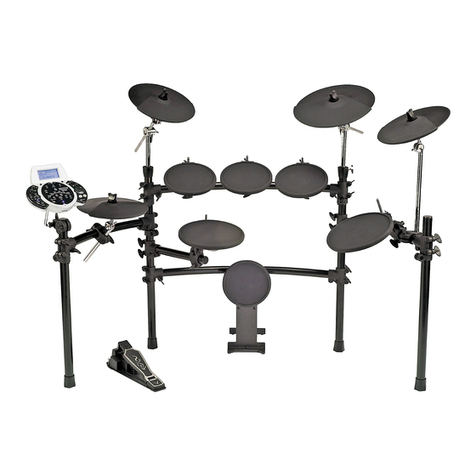
Simmons
Simmons SD9K User manual

Simmons
Simmons SD9K User manual
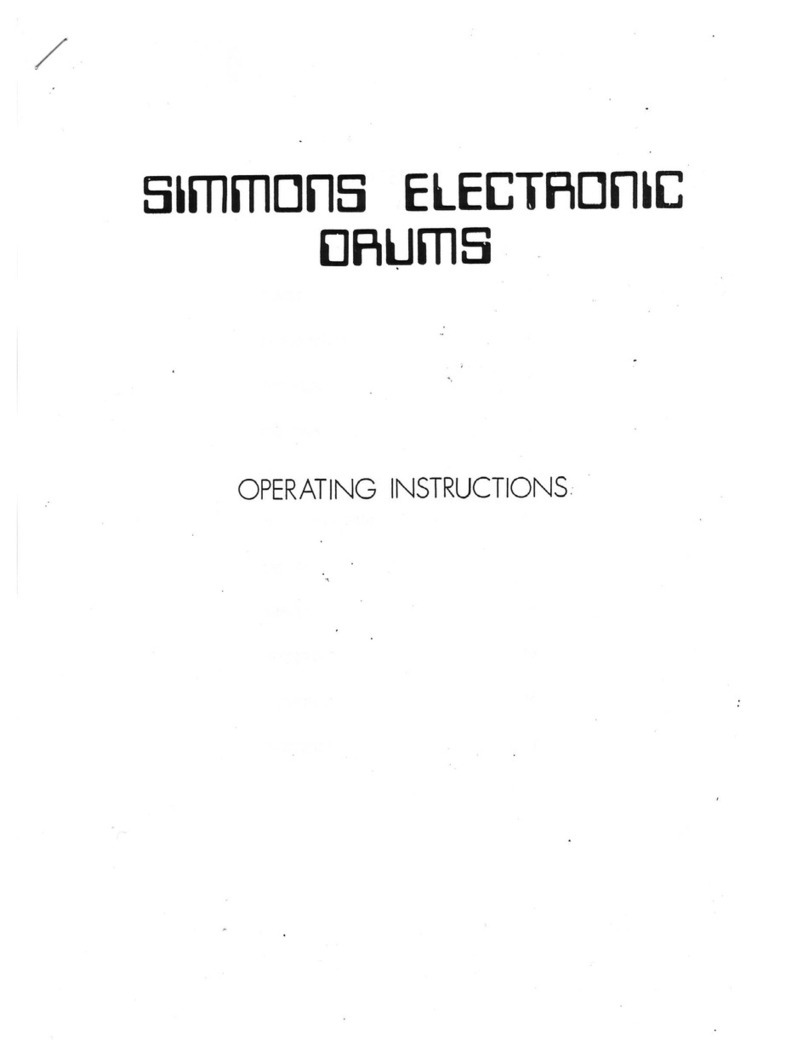
Simmons
Simmons Five User manual

Simmons
Simmons SDMK4 User manual

Simmons
Simmons TITAN 50 User manual

Simmons
Simmons SD500 User manual

Simmons
Simmons SDXpress2 User manual
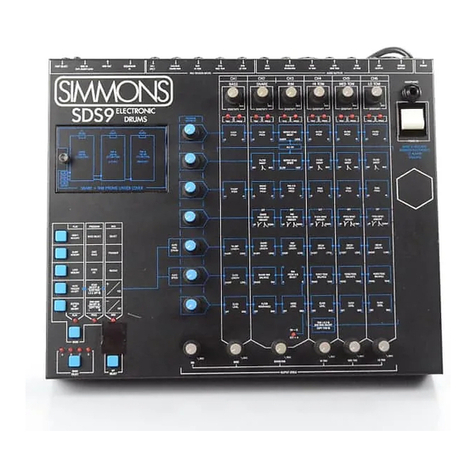
Simmons
Simmons SDS 9 User manual

Simmons
Simmons SD7PK User manual

Simmons
Simmons SD1 User manual
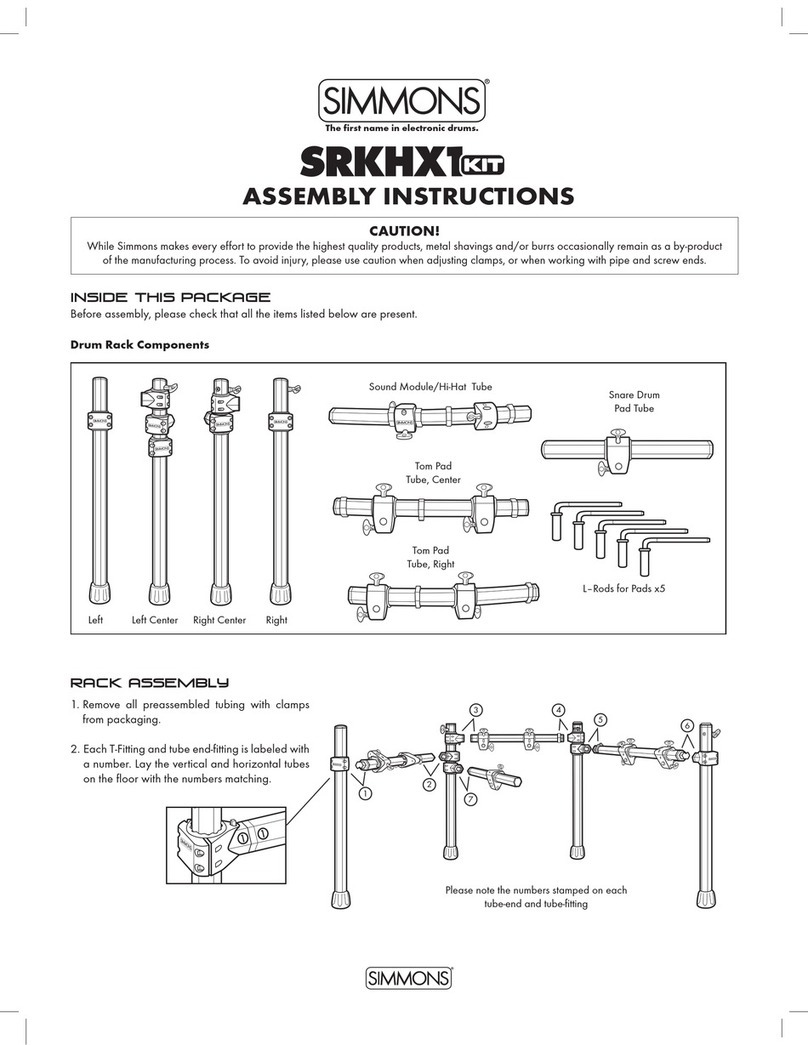
Simmons
Simmons SD1500 User manual

Simmons
Simmons TITAN 20 User manual
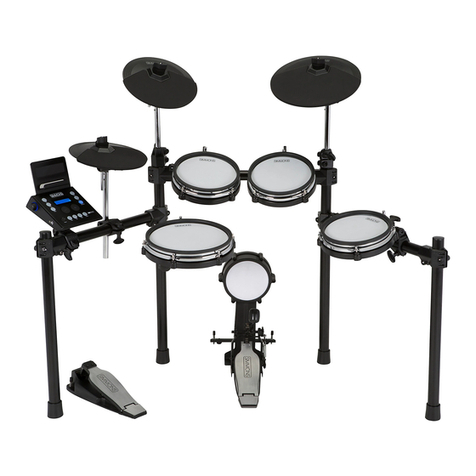
Simmons
Simmons SD600 User manual

Simmons
Simmons SD1000 User manual

Simmons
Simmons SD300KIT User manual

Simmons
Simmons SDS 800 User manual

Simmons
Simmons SDMP1 User manual

Simmons
Simmons SD1200 User manual
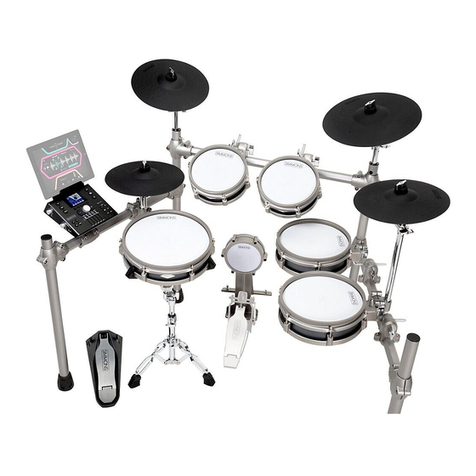
Simmons
Simmons SD1250 User manual

Simmons
Simmons SDS 9 User manual



